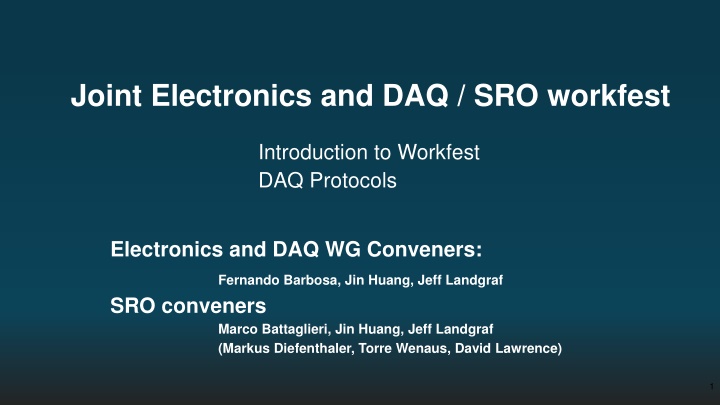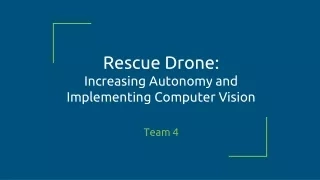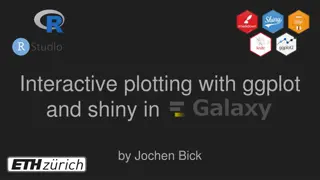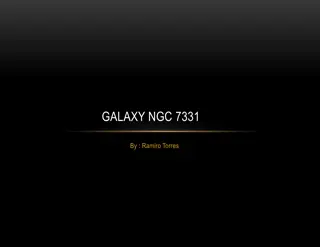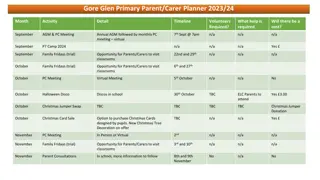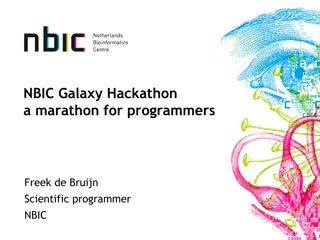Exploring The Galaxy with Glen Beane: Senior Software Engineer
The Jackson Laboratory based in Bar Harbor, Maine, is a non-profit genetics research center founded in 1929 with over 1,300 employees and a $200 million budget. Their Scientific Computing Group focuses on core software engineering and statistical analysis services for scientific software development, emphasizing High Performance Computing and domain expertise. The use of the Galaxy platform is highlighted for high-throughput sequencing analysis, RNA-Seq, DNA-Seq, ChIP-Seq, and other genomic analyses. The group also works on developing and wrapping new tools to enhance their research capabilities, supporting collaboration and sharing of data, workflows, and histories.
Download Presentation

Please find below an Image/Link to download the presentation.
The content on the website is provided AS IS for your information and personal use only. It may not be sold, licensed, or shared on other websites without obtaining consent from the author.If you encounter any issues during the download, it is possible that the publisher has removed the file from their server.
You are allowed to download the files provided on this website for personal or commercial use, subject to the condition that they are used lawfully. All files are the property of their respective owners.
The content on the website is provided AS IS for your information and personal use only. It may not be sold, licensed, or shared on other websites without obtaining consent from the author.
E N D
Presentation Transcript
Joint Electronics and DAQ / SRO workfest Introduction to Workfest DAQ Protocols Electronics and DAQ WG Conveners: Fernando Barbosa, Jin Huang, Jeff Landgraf SRO conveners Marco Battaglieri, Jin Huang, Jeff Landgraf (Markus Diefenthaler, Torre Wenaus, David Lawrence) 1
Workfest Introduction The guiding principle of this workfest is discuss how the Electronics, DAQ, and the SRO WGs are going to interact with the DSCs and the software WGs during the detector development phase of the project Make the design of the Electronics/DAQ and Software more specific Evaluate the needs that the DSCs have from the Electronics/DAQ and SRO groups Common Solutions Hardware / Expertise Specifications / Joint discussion and development of specifications Evaluate how to handle immediate detector prototyping needs with the need to develop towards the final streaming system with final ASICs Evaluate what sort of tests, or mock data challenges can be done to demonstrate the streaming concepts Reconstruction & Event selection Time synchronization Automatic calibration 7/25/2024 Electronics, DAQ & SRO Joint Workfest 2
Schedule Afternoon Morning Some Late Schedule Changes https://indico.bnl.gov/event/20727/sessions/7431/#20240725 Note Metadata/SC discussion doesn t match indico page In some cases discussion is interspersed, in others it is separated Don t worry about the schedule though, the point of all talks is to foster discussion! 7/25/2024 Electronics, DAQ & SRO Joint Workfest 3
DAQ / SRO Protocols Global Timing Unit (GTU) -Interfaces to Collider, Run Control & DAM -Config & Control -Clock & Timing Echelon 1 On Detector (BNL) SMT BGA Echelon 0 Sensor Adapter Front End Board (FEB) Readout Board (RDO) Computing Name Data Aggregation Module (DAM) Echelon 1 (JLAB) (Fiber Protocol) ePIC DAQ protocol FEB/RDO Echelon 0 Protocol SRO protocol 7/25/2024 Electronics, DAQ & SRO Joint Workfest 4
DAQ / SRO Protocols Global Timing Unit (GTU) Firmware variations by ASIC Count Firmware Hardware Design Unit Testing at BNL? -Interfaces to Collider, Run Control & DAM -Config & Control -Clock & Timing 620 TOF (EICROC) TOF Yes Some Hardware variations 1240 dRICH (ALCOR) INFN No Echelon 1 510 Calorimeters (CALOROC) (as per tof) Yes Need to clear up groups responsible, clarify corresponding P6 activities for each flavor of board and which flavor of firmware On Detector 160 MPGDs (SALSA) (as per tof) Yes (BNL) 32 Low Q2 (Timepix) spyder4? No SMT BGA 100 Discrete (as per tof) Yes Echelon 0 160 MAPS Detector side fiber interface Yes 340 Astropix NASA Yes 100 channels FLASH Direct Photon JLAB Discuss ASIC interfaces next monthly status update Sensor Adapter Front End Board (FEB) Readout Board (RDO) Computing Name Data Aggregation Module (DAM) Echelon 1 (JLAB) (Fiber Protocol) ePIC DAQ protocol FEB/RDO Echelon 0 Protocol SRO protocol 7/25/2024 Electronics, DAQ & SRO Joint Workfest 5
DAQ / SRO Protocols Global Timing Unit (GTU) -Interfaces to Collider, Run Control & DAM -Config & Control -Clock & Timing Echelon 1 On Detector Subject of most of this talk (BNL) SMT BGA Echelon 0 Link to Draft Document https://brookhavenlab.sharepoint.com/:f:/s/EICPublicSharingDocs/Eo2ZtIxpVIZIguncUBUJmtIB10gn_fHJ0dIAJHb0WusJAA?e=OypaSe Mattermost Channel Sensor Adapter Front End Board (FEB) Readout Board (RDO) Computing Name Data Aggregation Module (DAM) https://chat.epic-eic.org/main/channels/daq----gtudamrdo-fiber-protocol-discussion Echelon 1 (JLAB) (Fiber Protocol) ePIC DAQ protocol FEB/RDO Echelon 0 Protocol SRO protocol 7/25/2024 Electronics, DAQ & SRO Joint Workfest 6
DAQ / SRO Protocols Data file s are: Global Timing Unit (GTU) Timeframes are continuous and ordered within file Timeframes contain all detector information -Interfaces to Collider, Run Control & DAM -Config & Control -Clock & Timing Echelon 1 Some data is attached to a physical run period Some data is continuously generated On Detector (BNL) SMT BGA Echelon 0 Scaler Layer 2 FBDC Echelon 1 (BNL) FBDC Sensor Adapter Front End Board (FEB) Readout Board (RDO) Computing Name FBDC Data Aggregation Module (DAM) Echelon 1 Layer 2 Layer 3 FBDC (JLAB) (Fiber Protocol) ePIC DAQ protocol Layer 2 Layer 3 FBDC FEB/RDO Layer 2 Layer 3 FBDC Echelon 1 (JLAB) ( . . . ) ( . . . ) Echelon 0 Protocol ( . . . ) FBDC Layer 2 Layer 3 File: TF(DAM) Unit TF SRO protocol Route(TF%N) Route((TF/Nfile)%N) 7/25/2024 Electronics, DAQ & SRO Joint Workfest 7
DAQ / SRO Protocols Data file s are: Global Timing Unit (GTU) Timeframes are continuous and ordered Timeframes contain all detector information -Interfaces to Collider, Run Control & DAM -Config & Control -Clock & Timing Echelon 1 Some data is attached to a physical run period Some data is continuously generated On Detector (BNL) SMT BGA Echelon 0 (Or Echelon 1) Scaler Layer 2 FBDC Echelon 1 (BNL) FBDC Sensor Adapter Front End Board (FEB) Readout Board (RDO) Computing Name FBDC Data Aggregation Module (DAM) Echelon 1 Layer 2 Layer 3 FBDC (JLAB) (Fiber Protocol) ePIC DAQ protocol Layer 2 Layer 3 FBDC FEB/RDO Layer 2 Layer 3 FBDC Echelon 1 (JLAB) ( . . . ) ( . . . ) Echelon 0 Protocol ( . . . ) FBDC Layer 2 Layer 3 SRO protocol File: (ordered contiguous TF) Unit: TF TF(DAM) 7/25/2024 Electronics, DAQ & SRO Joint Workfest 8
Fiber Protocol (ePIC DAQ protocol) Fiber Links between GTU/RDO/DAM/FBDC RDO 48 GTYP transceivers (up to 32.65gbps) expect 14gbps firefly (25 is possible) 8gbps 8b10b -> 64bits synced to BCO FBDC PCIe Gen5 (16 GTYP transceivers) WORLD 100GbE (GTM transceivers) GTU 4 GTYP transceivers (up to 32.65gbps) expect 14gbps firefly (25 is possible) encoding? Synced to BCO but not 8b/10b? - up to 80 bits x 3 links? - fourth link used for dedicated timing 7/25/2024 Electronics, DAQ & SRO Joint Workfest 9
GTU Fanout Scheme 1. Distribute copies of GTU signals to O(140) DAM boards to be forwarded to RDO. These signals should reach RDO boards with fixed latency (Assume 64 bits / BX) 2. Distribute copies of a dedicated clock to O(140) DAM boards 3. Independently address (some) commands to up to 32 detectors/groups of detectors 4. Receive in the GTU at least N bits of Flow Control / Time Frame Status information from O(140) DAM boards. (N = up to 64) 5. Receive in the GTU at least N bits of information constructed for triggering from a specific selection of DAM boards TBD (N = up to 160) GTU is going to be complex: Define a group to discuss the hardware details & options Project does have PED engineering defined for this, but we should consider options? Tree of FELIX boards? 7/25/2024 Electronics, DAQ & SRO Joint Workfest 10
Communication Channels DAM_CTRL = 64 bits. Copied to all DAM (or all DAM for single detector) Forwarded to RDO_CTRL DAM_STATUS = 20(64) bits DAM information copied back to GTU. Timeframe handling, Error conditions, Dam responses (e.g. returning control after config) TRG_CTRL = 20(160) bits Send trigger commands (to selected DAM boards) TRG_STATUS = 160 bits Return summary information (from selected DAM boards) RDO_CTRL = 64 bits RDO_DATA RDO headers + ASIC + SC data Clock + RDO commands 7/25/2024 Electronics, DAQ & SRO Joint Workfest 11
Feature Implementation 1. Bunch definition BCO itself: BCO verification (require verification at least every timeframe) Periodic full specification Checksum-like verification of bits over many bunchcrossings (7 bit scheme?) Beam Info (REV_TIC x 2, BUNCH_FILLED x2), Sent every bunch Resync (issued by RDO or by GTU) 64 bit BCO Time frames maximum 16 bits 2. Time Frame Handling Start frame Synchronous command Time frame identification High order bits of BCO? Re-usable identifier (token) 7/25/2024 Electronics, DAQ & SRO Joint Workfest 12
Feature Implementation (continued) 3. RDO and DAM Data Processing Flags. Identify periods when unprocessed data should be kept 4. Firmware, Run Control Configuration & Resets Likely these involve giving control to the DAM boards and selecting appropriate data to be loaded via run control or slow controls. But need command to indicate to DAM board to take over, and for the DAM boards to relinquish control when they are finished. Fast configuration We have had discussions of potential configuration during a run Could involve calibration control, error mitigation and recovery. Possibly to be handled by standard configuration scheme, but if so need to indicate when certain components are disabled for timeframe building and coherency 5. Triggering Firing hardware actions / activities (e.g. laser or pulser system, requests to read slow controls information, or to write out unzero-suppressed for a short time to calculate pedestals) Firmware trigger as needed by dRICH / low Q2 taggers 7/25/2024 Electronics, DAQ & SRO Joint Workfest 13
Feature Implementation (Continued) 6. Flow control Sense ASIC overflow/truncation RDO overflow/truncation DAM overflow/truncation Prevention strategy Sense truncation and apply deadtimes? Force deadtime before truncation occurs? We don t need perfection in avoiding overflow, but we must clearly sense, mark, and minimize overflow situations! 7. Data link Will consist of multiplexed headers, ASIC data, & SC data. Define headers Provide link between BCO and ASIC clock based time measurements 7/25/2024 Electronics, DAQ & SRO Joint Workfest 14
Synchronous Command Structure Started to think about the kinds of define commands to implement these features. Proposed command structure This needs significant iteration! 7/25/2024 Electronics, DAQ & SRO Joint Workfest 15
Example: (dRICH tag based on external detector) Given the requirement for a backup triggered readout for RICH, it is necessary to carefully define the physics trigger rate, trigger conditions, and trigger latency in order to facilitate design of the RICH front-end. ePIC depends upon a flexible scheme in which sufficient bandwidth is available for data to the dRICH DAM in the worst case. (> 4x safety). The selecting detectors (ex FWD HCAL) generate information characterizing beam in O(10us). The decision is made by the GTU and returned to DAM boards with fixed latency. The maximum latency is orders of magnitudes less than available buffering in DAM board memory. A hardware trigger is supported by the GTU but uses the same dRICH buffering scheme and delays as the firmware trigger option. FWD HCAL RDO RDO RDO RDO FWD HCAL RDO RDO RDO RDO FWD HCAL FWD HCAL FWD HCAL FWD HCAL FWD HCAL dRICH RDO_DATA 48 48 48 48 48 48 FWD HCAL DAM DAM DAM FWD HCAL FWD HCAL Activitiy Notes dRICH DAM dRICH DAM dRICH DAM Data Arrives at DAMs <=10us from Bunch Crossing Data Evaluation in HCAL DAMs 100ns DAM_CTRL TRG_STATUS 64 bits Bunch Data Fixed delay O(10us) 3 30 TRG_STATUS to GTU Data transmitted to GTU after fixed delay from source crossing O(10us) (Keep/Drop Bunch bit) Trigger Evaluation on GTU Fixed Latency O(100ns) GTU Keep/Drop Bit to (dRICH) DAMs Fixed Latency O(40ns) Fixed delay O(10us) Drop data / forward data Drop/Forward after fixed time O(11us) Ex: Hcal generates trigger dRICH is triggered Hardware Trigger Option DAM Buffer 16GB Buffer Time available 2.6 seconds
Example: (dRICH tag based on external detector) Selection criteria : count of hits in fwd hcal > N Fwd HCAL State machine: GTU State machine Rcv from TRG_STATUS (each BX) 1. Sum Fwd HCAL hits from TRG_STATUS Nhits/BX: Circular Buffer ~1000 deep (10us) Each BX: 1. Send accept via TRG_CTRL if hits [curr 10] > Threshold, release otherwise Each BX: 1. Send Nhits/BX[curr 10us] via TRG_STATUS 2. Zero Nhits/BX[curr-10us] RCV via RDO_DATA : 1. Evaluate hits count & associated BX 2. Add hit count to Nhits/BX[Associated BX] dRICH DAM State machine RCV via RDO_DATA: 1. Store Data indexed by associated BX RCV via TRG_CTRL (each BX) 1. If accept, forward BX info to FBDC 2. If abort, drop BX info The state machines are simple, but one must evaluate Simultaneous usage of communication pathway resources Edge conditions Flexibility
Example: (dRICH tag based on hardware input) Flexibility (Hardware Trigger Added) GTU State machine Each BX 1. Store interaction tagger Bit Minor Change Each BX: 1. Send accept via TRG_CTRL if tagger bit set, release otherwise FWD HCAL RDO RDO RDO RDO FWD HCAL FWD HCAL dRICH dRICH DAM State machine 48 48 48 dRICH DAM dRICH DAM dRICH DAM Interaction Tagger RCV via RDO_DATA: 1. Store Data indexed by associated BX No Change DAM_CTRL 30 RCV via TRG_CTRL (each BX) 1. If accept, forward BX info to FBDC 2. If abort, drop BX info (Keep/Drop Bunch bit) GTU Fixed delay O(10us) Hardware Trigger Option
Example: (dRICH tag based on dRICH analysis) Flexibility (dRICH local Analysis) (See Alessandro Lonardo s talk in interaction tagger session) 8 X-DAM 40 RDO dRICH DAM State machine RCV via RDO_DATA: 1. Store Data indexed by associated BX Versal FPGA RDO No Change ePIC Handling Apeiron RCV via TRG_CTRL (each BX) 1. If accept, forward BX info to FBDC 2. If abort, drop BX info Accept / Abort RCV via RDO_DATA: 1. Complex Multi-FPGA ML implementation with deterministic time 2. Send abort/accept via TRG_STATUS to GTU GTU State machine Rcv from TRG_STATUS (each BX) 1. Store accept/abort from TRG_STATUS New Minor Change Each BX: 1. Send accept via TRG_CTRL any accept, release otherwise
Questions / Discussion 7/25/2024 Electronics, DAQ & SRO Joint Workfest 20
